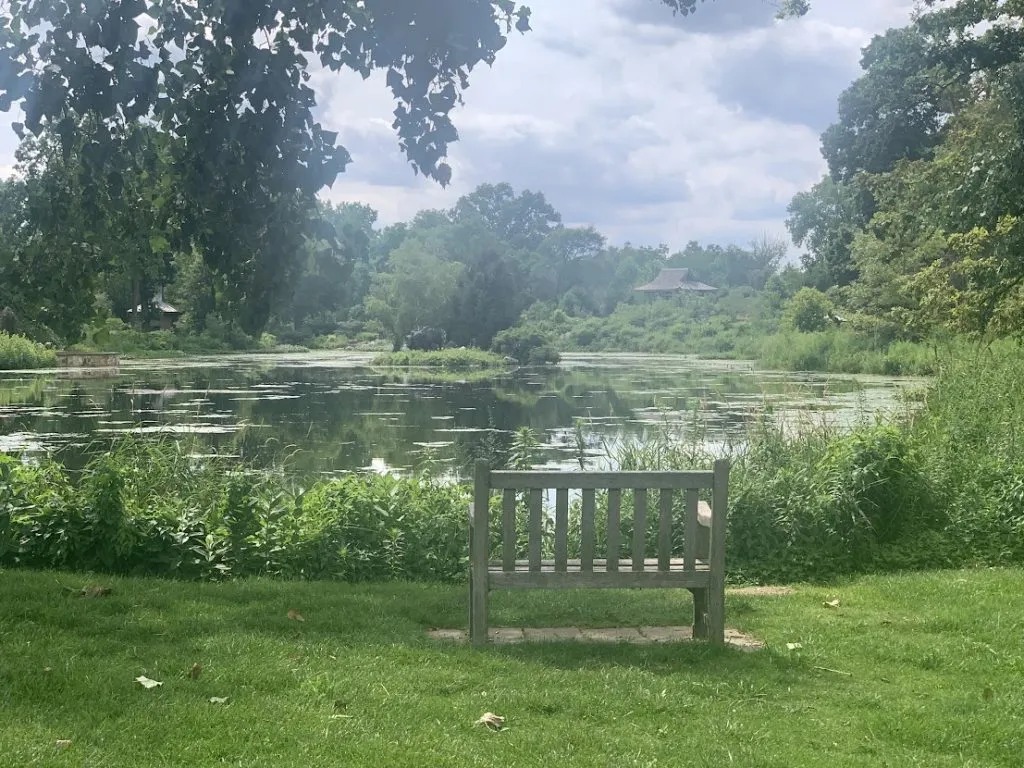One Perfect Day in Elkhart, Indiana
The first thing you notice in Elkhart is the light. It doesn’t rush in; it seeps over rooftops, warming the brickwork and catching on the ripples of the Elkhart River. Before the city fully wakes, trucks move along freight routes, and the low whistle of a train slides in from the distance. Side streets smell faintly of fresh bread, the kind that comes from bakeries baking long before dawn.
By the time you reach downtown, the sidewalks are still easy to navigate. Storefronts stand side by side like old neighbors—restored façades, hand-painted signs, window displays that change with the seasons. A few murals add splashes of color, each one telling a piece of the city’s story. The riverfront walk is especially quiet at this hour, with joggers moving past at a steady, almost meditative pace.
Breakfast choices set the day’s tone. You can sit in a family-run diner with Formica tables and laminated menus, where the coffee is strong and refills come without asking. Or you might head to a small bakery, choosing between a still-warm maple-glazed doughnut or a flaky cinnamon roll. Either way, breakfast feels like a conversation with the city’s personality—practical, warm, and anchored in tradition.
The RV/MH Hall of Fame makes a fitting first destination. It’s more than a museum; it’s a walk through decades of American mobility. Retro campers, glossy motorhomes, and detailed displays reveal the depth of craftsmanship that shaped Elkhart’s identity. If your interest leans toward art, the Midwest Museum of American Art offers an equally compelling start. Inside, regional works hang alongside pieces by nationally recognized artists, giving the morning a slower, more reflective rhythm.
Late Morning to Early Afternoon – Where Culture and Craft Meet
By mid-morning, Elkhart’s streets have gathered momentum. Shops are open, doors propped wide to invite both air and people in. Antique stores mix polished furniture with weathered tools, glassware with a century’s worth of patina, and vintage textiles that seem to hold the fingerprints of their makers. Artisan studios bring another dimension—ceramic bowls still warm from the kiln, handwoven scarves draped over wooden racks, and jewelry laid out like a private treasure collection.
A short walk takes you to the Wellfield Botanic Gardens, one of the city’s most peaceful corners. The gardens are more than just decorative; they are built around natural springs that have been part of Elkhart’s water supply for over a hundred years. Winding paths lead you through themed sections—a Japanese garden with a koi pond, seasonal beds alive with tulips or chrysanthemums, shaded groves where benches invite you to pause. The water features here aren’t just ornamental; they connect the place to the city’s history in a way that feels both tangible and understated.
Lunchtime in Elkhart offers variety without excess. Riverside cafés serve fresh soups and sandwiches on homemade bread, while farm-to-table restaurants highlight the best of the season. In summer, you might find a salad topped with heirloom tomatoes and goat cheese; in colder months, perhaps roasted squash soup with crusty bread. Meals often feel like collaborations between local growers and chefs, with flavors that follow the calendar.
For a casual interlude, local breweries offer an easygoing midday stop. A honey-infused pale ale or a dark stout aged in bourbon barrels might share the menu with small plates of cheese and charcuterie. Sitting at a communal table turns lunch into conversation, and it’s not unusual to hear locals recommend a hidden trail, a favorite shop, or a seasonal festival worth staying for.
Mid-Afternoon Adventures – Between History and Play
Afternoons in Elkhart can tilt toward history, leisure, or a mix of both. The National New York Central Railroad Museum appeals to anyone curious about how railroads built towns like this one. Inside, you’ll find photographs, tools, and models that tell the story of freight and passenger lines. Outside, restored locomotives and cabooses stand ready for exploration. Stepping into a passenger car from the 1940s, with its worn upholstery and narrow aisles, gives a tactile sense of how people once traveled.
If you prefer something with a lighter, more whimsical touch, Linton’s Enchanted Gardens blends gardening with retail and seasonal displays. In summer, bright flowers spill from every planter, and koi dart through clear ponds. In autumn, pumpkins and corn stalks take over; in winter, miniature villages sparkle under strings of lights. It’s a place where families wander, gardeners look for ideas, and shoppers find everything from plants to home décor.
For a slower pace, Island Park offers shaded walking paths, river overlooks, and open lawns. Sitting under a tall sycamore tree here gives you space to process the day so far. On warm afternoons, kayak rentals let you see Elkhart from the water. Paddling under bridges and along tree-lined banks, you may spot herons, ducks, and turtles sunning themselves on logs. The river’s gentle current makes this accessible even for beginners.
Nearby Amish markets provide yet another shift in atmosphere. Wooden shelves hold jars of jam, pickled vegetables, and loaves of bread wrapped in plain paper. Hand-stitched quilts and small wooden toys sit neatly on display. The lack of electronic payment options, the slower pace, and the focus on craftsmanship make these visits feel removed from the rush of modern retail.
Golden Hour to Evening – Food, Music, and Small-City Glow
As the afternoon fades, Elkhart changes tempo. Light filters through street trees, throwing long shadows across sidewalks and glowing off the water. Patios begin to fill—some attached to wine bars with curated selections, others to breweries serving seasonal drafts. From here, you can watch the gradual shift from day to evening, a process that seems slower and more deliberate than in larger cities.
Dinner here can take many forms. A grillhouse might serve thick pork chops with roasted potatoes, the plate balanced by a side of fresh greens. A small bistro could offer handmade pasta with a sauce built from seasonal vegetables. The range of flavors reflects a blend of Midwestern roots and outside influences brought in by chefs who’ve lived or trained elsewhere.
In summer, outdoor seating is common, often paired with live music—a guitar, a jazz trio, or a small folk band. In cooler months, the draw moves indoors, where exposed brick walls, low lighting, and polished wood bars create a warm setting. Some venues feature high-backed, vintage restaurant bar stools, a detail that adds both comfort and a touch of nostalgia.
The Lerner Theatre provides a cultural anchor for the evening. Its restored 1920s interior is worth seeing whether you have a ticket or not. The theater hosts an array of performances—touring Broadway productions, concerts, local plays—that keep the city’s arts scene active year-round.
Seasonal events add variety. In summer, art walks fill the streets with painters, sculptors, and live demonstrations. In winter, holiday markets bring mulled cider, handmade gifts, and the scent of pine into the cold air. Each creates a sense of gathering that goes beyond the shopping or entertainment itself.
Nightcap and Reflection – Ending the Day the Elkhart Way
The last chapter of the day can be as sweet or as smooth as you want it to be. Ice cream parlors serve sundaes layered with hot fudge, hand-scooped shakes, and seasonal flavors—fresh strawberry in June, pumpkin in October. The décor often leans toward retro, with neon signs and chrome details that give the space a sense of history.
For something quieter and more intimate, a speakeasy-style bar offers low lighting, a small but precise menu, and bartenders who work with house-infused spirits. Cocktails might feature herbs grown locally or syrups made in-house, and each drink comes with a short story if you ask for it.
A final walk along the riverfront ties the day together. Streetlamps reflect in the water, creating shifting patterns that follow you as you walk. The bridges, busy with daytime traffic earlier, now stand still against the night sky. The air carries a faint mix of water, earth, and woodsmoke from nearby chimneys.
By the time you step away from the river, Elkhart has left its mark—not in a single landmark or attraction, but in the steady layering of moments. The industry, artistry, and community here don’t compete for attention; they share it, blending into a rhythm that feels whole. One day is enough to see the shape of it, but it’s the kind of place that leaves you thinking about a return before you’ve even left.







